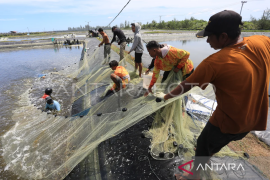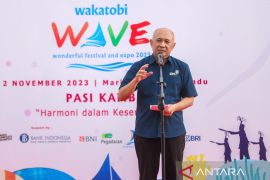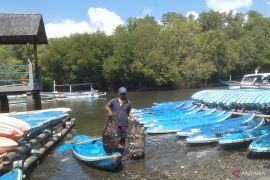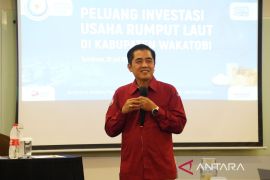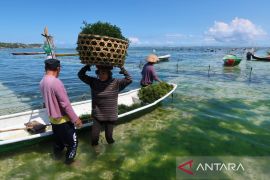"The government, in this case the Ministry of Marine Affairs and Fisheries (KKP), will compile and finish the roadmap soon to provide a guideline for development of upstream and downstream seaweed industries," Director General of Fish Processing and Marketing of the KKP ministry Saut Hutagalung said on Thursday.
The roadmap needs to be developed as Indonesia, whose seaweed production increases about two million tons per year, is host to about 555 seaweed species of which 55 species has high economic values.
The roadmap is also important to answer the need of seaweed farmers and producers for zoning of seaweed culture areas.
Of the 55 seaweed species, two varieties, namely Eucheuma cottnii and Gracillaria spp, have been popular and developed so far to produce processed carrageenan and geltin.
The director general said that besides the two types, there are other species which had promising business prospect, namely brown algae (alginate) and green algae (ulva) seaweeds. This is particularly for cosmetic industry.
The government, therefore, encourages industries and seaweed stakeholders to increase research and development efforts for the cultivation of the varieties which have high economic values.
Saut stressed the importance of carrying out researches from the upstream areas (such as selections of locations and seeds) to the downstream field (involving the development of technology).
For the development of seaweed in the country, the Indonesian Seaweed Association (ARLI) has expressed its desire for zoning of seaweed areas so that seaweed cultivation has special zones in an effort to prevent potential conflicts between culture fisheries and other sectors.
"We need special zoning to prevent the outbreak of conflict," Safari Aziz, the general chairman of ARLI, said on Wednesday.
He said that the development of seaweed in various provinces was hampered by the master plans of other sectors such as mining, energy and tourism sectors. He cited as an example the development of tourism in Bali where hotel construction around coastal areas had hampered the development of seaweed in the area.
"The development of hotels in the coastal areas sparked protest from the local people and seaweed formers because they are prohibited from drying their seaweed products there," Aziz said.
Besides that, mining companies plans to develop smelters and power plants, like in South Sulawesi and East Java, also threaten to marginalize seaweed farmers because they have to reclaim coastal areas when they build the projects.
Aziz said the availability of zoning for special seaweed culture and production will make it easier for accurate data gathering on seaweed development and for the continuation of seaweed production business.
He also questioned the accuracy of the KKP data on the countrys seaweed production, which was recorded at 8.2 million tons in 2013, or about 9.33 percent above the target set at 7.5 million tons.
"The accuracy of the data is questionable. It is not in line with the worlds consumption and reality in the field," the ARLI general chairman said.
The ministry targeted national seaweed production of 7.5 million tons in 2013, rising by 30 percent from 5.2 million tons in 2012. For 2014, the ministry aims to produce 10 million tons of wet seaweed or about one million tons of dried seaweed.
In the meantime, Head of South Sulawesis Plant Quarantine and Biodiversity Security Center Antarjo Dikin said in Makassar last month that the country exported 174 thousand tons of seaweed worth US$132.48 million in 2013.
He said that about 0.7 million tons of seaweed at home were for raw materials to be processed into food, fish feed, paint, ceramic, cosmetics, toothpaste, hair tonics and pharmaceutical products.
Of the exports, some 50 percent were shipped to China while the remaining ones went to Europe such as the Netherlands, Denmark, France, Spain and Britain.
"Seaweed prospect is good because it creates new promising economic field and it serves as a raw material for healthy food," Antarjo said.
As for seaweed products, the KKP ministry is targeting 205,000 tons this year, in the form of Alkali Treated Carrageenan (ATC), Semi Refined Carrageenan (SRC), Refined Carrageenan (RC), jelly, alginates, and other formulated products.
Indonesia has the potential to cultivate seaweed on 1.1 million hectares. The countrys biodiversity of seaweed species is vast, amounting to more than 555 species, 45 percent of all seaweed species worldwide, including Glacilaria, Gelidium, Eucheuma, Hypnea, Sargassum and Turbinaria
According to Mukti Sardjono, an expert staff of the agriculture minister on environment affairs, seaweed has high economic competitiveness and is Eco-friendly because it can reduce emission of gases.
"Indonesia is the worlds third biggest seaweed supplier with a total production of 6.5 million tons in 2012. Therefore, we should optimize our efforts to develop seaweed," Mukti Sardjono said.
He said that seaweed was able to reduce the depletion of the ozone layers. Unluckily, however, the global warming, climate change and human activities have also reduced the world seaweed stretches by about seven percent per annum. (*)
(T.A014/b003/B003)
Reporter: Andi Abdussalam
Editor: Fardah Assegaf
Copyright © ANTARA 2014
